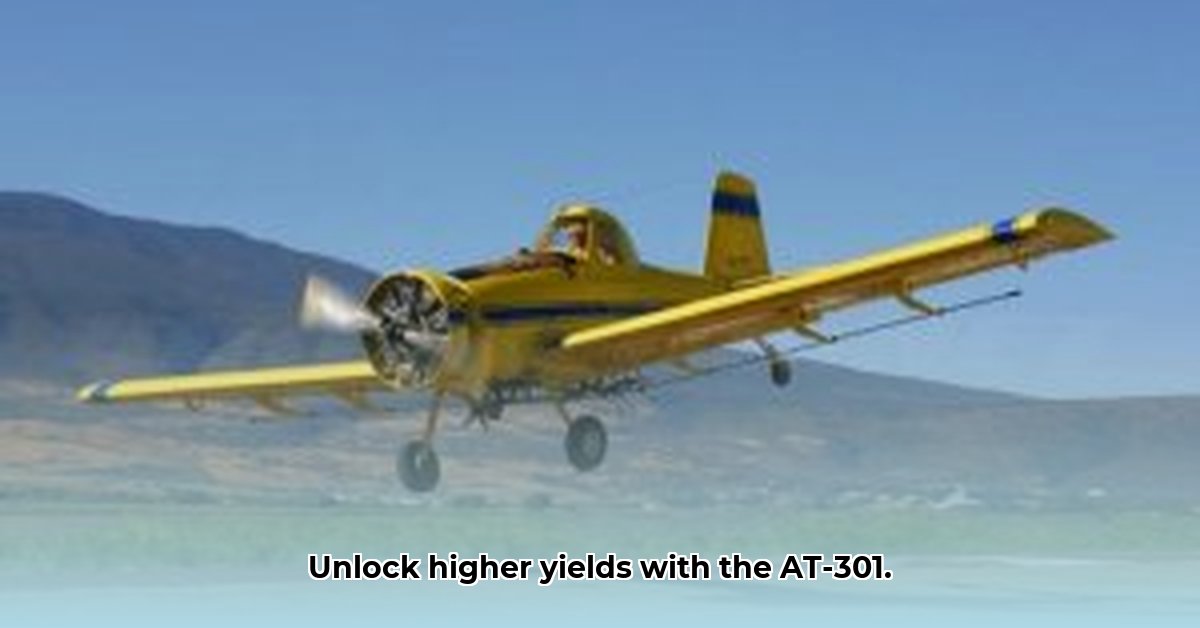
The Air Tractor AT-301 is a single-engine, high-wing aircraft specifically designed for agricultural applications. Part of the renowned Air Tractor AT-300 series, the AT-301 stands out for its balance of affordability and robust performance in various agricultural tasks. This guide provides a detailed technical overview, comparing it to its turboprop counterparts and exploring its overall operational costs. For more detailed cockpit information, see the AT-300 Cockpit Guide.
Technical Specifications: A Detailed Look
The AT-301's performance stems from its powerful engine and efficient design. Key specifications are outlined below, though precise figures can vary based on configuration and payload. Always consult the manufacturer's specifications for precise data.
| Specification | Value (Approximate) | Notes |
|---|---|---|
| Engine | Pratt & Whitney Canada R-985 Wasp Junior | A reliable, high-horsepower piston engine. |
| Max Takeoff Weight | 16,500 lbs (approx.) | Varies depending on configuration and payload. |
| Useful Load | 8,000 lbs (approx.) | Weight capacity for chemicals, seeds, or fertilizers. |
| Fuel Capacity | 1,000 gallons (approx.) | Range highly dependent on payload, weather, and operational conditions. |
| Cruise Speed | 130-150 knots (approx.) | Dependent on factors including altitude. |
| Range | 700+ nautical miles (approx.) | Varies significantly based on payload and operational conditions. |
| Wingspan | 60 feet (approx.) | Large wingspan for stability and efficient lift. |
| Length | 45 feet (approx.) | Overall aircraft length. |
| Height | 16 feet (approx.) | Vertical dimension of the aircraft. |
Isn't it impressive how much this aircraft can carry? What other agricultural aircraft offer such a powerful payload capacity within a relatively compact frame?
Operational Capabilities: Versatility in Application
The AT-301 excels in various agricultural tasks. Its adaptability extends to different spray systems, allowing for both broad coverage via booms and precise targeting for specific areas. This versatility makes it a valuable asset for a wide range of agricultural operations. It's efficient in seeding, fertilizing, and spraying applications, offering precision and coverage adapted to the specific needs of the job.
AT-301 vs. Turboprop Variants: A Comparative Analysis
The AT-301's piston engine contrasts with the turboprop engines of the AT-302 and AT-400. Turboprops generally provide superior high-altitude performance, fuel efficiency, and higher power. However, the AT-301 often boasts a lower initial purchase price and potentially simpler maintenance. The choice between piston and turboprop depends on various factors. Considering operational altitude, typical payload, and budgetary constraints is vital. While turboprops generally excel at higher altitudes, the AT-301 might prove more cost-effective for lower-altitude operations with lighter payloads. A detailed cost-per-acre analysis, requiring extensive field data, is needed for a definitive conclusion. What are the practical implications of using a piston engine versus a turboprop in various agricultural settings?
Maintenance and Reliability: Ensuring Operational Readiness
The AT-301 features a relatively straightforward maintenance design. Its modular components facilitate repairs and part replacements. Access to certified mechanics and readily available parts are critical factors in maintaining operational readiness. Proactive maintenance is essential for maximizing the aircraft’s lifespan and ensuring reliable operation. What preventative maintenance strategies are most effective in extending the service life of an AT-301?
Regulatory Compliance: Navigating the Legal Landscape
Operating the AT-301 requires adherence to all relevant regulations from the Federal Aviation Administration (FAA) or its international equivalents. This includes airworthiness certificates, operational limitations, and rigorous maintenance schedules. Strict adherence to these regulations is crucial for safe and legal operation. Failure to comply can lead to significant penalties. How can pilots ensure consistent compliance with all regulatory requirements relating to agricultural aviation?
Cost Analysis: Assessing Total Cost of Ownership
Determining the total cost of ownership for an AT-301 necessitates considering several factors. Acquisition costs, fuel consumption, maintenance, insurance, and potential repairs all contribute to the overall expenses. A comprehensive cost analysis, utilizing detailed operational data and expert financial insights, is needed for an accurate assessment. Hidden costs such as downtime and unforeseen repairs should also be factored in. What are the major cost drivers that impact the overall economic viability of using an Air Tractor AT-301?
Conclusion: Selecting the Optimal Agricultural Aircraft
The Air Tractor AT-301 presents a compelling option for agricultural operations, particularly those focused on lower-altitude tasks and smaller payloads. Its affordability and relatively simple maintenance make it a potentially cost-effective choice for many farmers. However, the AT-302 and AT-400 turboprop models offer superior performance in terms of payload, speed, and high-altitude efficiency. Careful consideration of operational needs, budget, and long-term costs is crucial for making an informed selection. Remember to conduct a thorough cost-benefit analysis before investing in any aircraft.